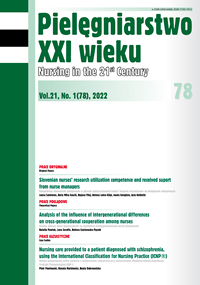Chronic hemodialysis patients at Fresenius Dialysis Centers from the Kuyavian-Pomeranian Voivodeship as primary health careand outpatient specialist care recipients– pilot study
DOI:
https://doi.org/10.2478/pielxxiw-2022-0005Keywords:
health care system, primary health care, specialist health care, hemodialysis, patientAbstract
CHRONIC HEMODIALYSIS PATIENTS AT FRESENIUS DIALYSIS CENTERS FROM THE KUYAVIAN-POMERANIAN VOIVODESHIP AS PRIMARY HEALTH CARE AND OUTPATIENT SPECIALIST CARE RECIPIENTS – PILOT STUDY
Introduction. Depending on the stage and progression of the disease, patients with chronic kidney disease (Przewlekła Choroba Nerek ) – CKD receive care at various levels of the Polish healthcare system, including primary care (Podstawowa Opieka Zdrowotna) – PHC teams, specialist clinics (Ambulatoryjna Opieka Specjalistyczna) – AOS, hospitals, as well as dialysis and transplant centers. The study aimed at analyzing the use of PHC and AOS services by hemodialysis patients treated in Fresenius Dialysis Centers from Poland
Material and methods. The study was based on a questionnaire survey and the Acceptance of Illness Scale questionnaire (Skala Akceptacji Choroby) – AIS. The total number of 159 patients participated in the study. The data was obtained from the Voivodeship Department of the National Health Fund on the use of PHC services in 2015, 2016 and 2017 by hemodialysis patients.
Results. The mean age of the respondents was 67.1±13.1 years. Almost all hemodialysis patients (98.7%) required additional treatment for CKD comorbidities. Over the last year before the survey, 5.7% of the respondents used PHC nursing services and no woman used PHC midwifery services. Participation in “Leki 75+” PHC program was indicated by 37.3% of those eligible. In the said
period, AOS services were used by 66.7% of the respondents, including a greater percentage of urban rather than rural inhabitants
(71.1% vs 58%; p<0.05).
Conclusions. Multiple morbidity and a high percentage of patients receiving AOS services in the analyzed period indicate the need to provide hemodialysis patients with coordinated care supervised by a dialysis center physician. Fulfilling PHC tasks by such physicians suggests the need to increase their numbers and to improve the financing of renal replacement therapy.
References
1. Rutkowski B, Król E. Epidemiology of chronic kidney disease in Central and Eastern Europe. Blood Purif. 2008; 26: 381-385. https://doi.org/10.1159/000137275.
2. Mathew AT, Fishbane S, Obi Y, et al. Preservation of residual kidney function in hemodialysis patients: reviving an old concept. Kidney Int. 2016; 90(2): 262-271.
3. Saha M, Allon M. Diagnosis, treatment, and prevention of hemodialysis emergencies. Clin. J. Am. Soc. Nephrol. 2016; 12: 357-69.
4. Zarządzenie nr 83/2019/DSOZ Prezesa Narodowego Funduszu Zdrowia z dnia 28 czerwca 2019 r. zmieniające zarządzenie w sprawie określenia warunków zawierania i realizacji umów w rodzaju świadczenia zdrowotne kontraktowane odrębnie.
5. Panasiuk-Kamińska K, Zubilewicz R, Szeliga-Król J, et al. Role of family physician in patient with chronic kidney disease care. Forum Medycyny Rodzinnej. 2016; 10(4): 189-195.
6. Kilańska D (ed.). Pielęgniarstwo w podstawowej opiece zdrowotnej. Lublin; Makmed: 2010.
7. Rozporządzenie Ministra Zdrowia z dnia 31 października 2019 r. zmieniające rozporządzenie w sprawie świadczeń gwarantowanych z zakresu podstawowej opieki zdrowotnej. (Dz. U. z 2019 r., poz. 2120).
8. Ustawa z dnia 27 października 2017 r. o podstawowej opiece zdrowotnej. (Dz.U. 2017r., poz. 2217).
9. Rozporządzenie Ministra Zdrowia z dnia 27 listopada 2019 r. w sprawie zakresu zadań lekarza podstawowej opieki zdrowotnej, pielęgniarki podstawowej opieki zdrowotnej i położnej podstawowej opieki zdrowotnej.(Dz. U. 2019 r., poz. 2335).
10. Rozporządzenie Ministra Zdrowia z dnia 13 kwietnia 2018 r. w sprawie recept. (Dz. U. z 2018 r., poz. 745).
11. Serwis polskiego rządu. Ministerstwo Zdrowia. Leki i wyroby medyczne. Refundacja. Programy lekowe. https://www.gov.pl/zdrowie/programy--lekowe (Dostęp 14.06.2020).
12. NIK: program Leki 75 plus poprawił dostęp seniorów do produktów leczniczych https://www.tvp.info/42325375/nik-program-leki-75-plus-poprawil-dostepseniorow-do-produktow-leczniczych (dostęp 12.12.2019).
13. Felton BJ, Revension TA, Hionrichsen GA. Skala akceptacji choroby AIS. [In:] Juczyński, Z. Narzędzia pomiaru w promocji i psychoonkologii zdrowia. Warszawa: Pracownia Testów Psychologicznych; 2009, p. 162-166.
14. Fal AM, Kiedlik D, Partyka O. Dostęp do świadczeń opieki zdrowotnej w obszarach miejskich i wiejskich w Polsce. Zeszyt Rolny nr 6. Warszawa: Ministerstwo Rolnictwa i Rozwoju Wsi; 2017.
15. Praca badawcza pt. „Pozyskanie nowych wskaźników z zakresu ochrony zdrowia przydatnych do oceny dostępności i jakości usług publicznych”. Raport z przebiegu prac. Jachranka, 2015.
16. Raport: system ochrony zdrowia w Polsce – stan obecny i pożądane kierunki zmian. KZD.034.001.2018 Nr ewid. 8/2019/megainfo/KZD. www.nik.gov.pl/plik/id,20223,vp,22913.pdf(dostęp 21.01.2020).
17. Nefron (Joint publication edited by Ryszarda Gellerta), Opieka koordynowana nad pacjentem z przewlekła chorobą nerek, 2018. http://nefron.org/opiekakoordynowana-nad-pacjentem-pchn/
18. Kalinowska A, Kowalczyk M, Pruszko C, et al. Dostęp do świadczeń nefrologicznych w Polsce. Raport. MAHTA Sp. z o.o; 2019.
19. Global Kidney Health Atlas 2019. www.theisn.org/global-atlas (dostęp 10.02.2020)
20. Global Kidney Health Atlas 2017 https://www.theisn.org/images/ISN_advocacy/GKHAtlas_Linked_Compressed1.pdf (dostęp 10.02.2020)
21. Coelho A, Sá HO, Diniz JA, et al. The integrated management for renal replacement therapy in Portugal. Hemodialysis International 2014; 18(1): 175-184. doi.org/10.1111/hdi.12064.
22. Coelho A, Leone C, Ribeiro V, et al. Integrated Disease Management: A Critical Review of Foreign and Portuguese Experience. Acta Med. Port. 2014; 27(1): 116-125.
Downloads
Published
Issue
Section
License
Copyright (c) 2022 Authors

This work is licensed under a Creative Commons Attribution 4.0 International License.




